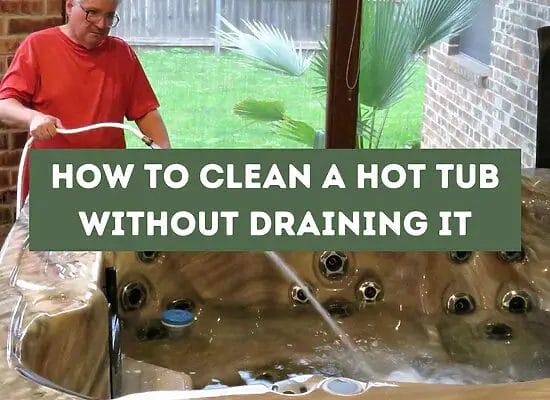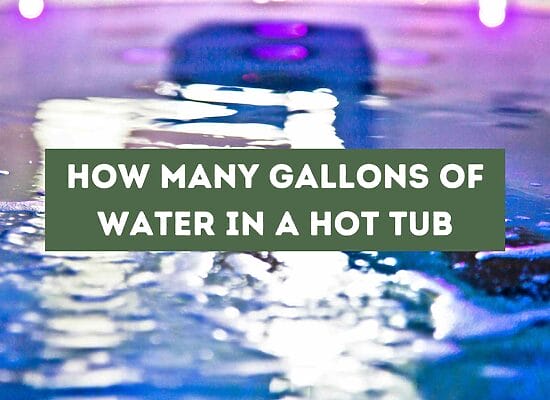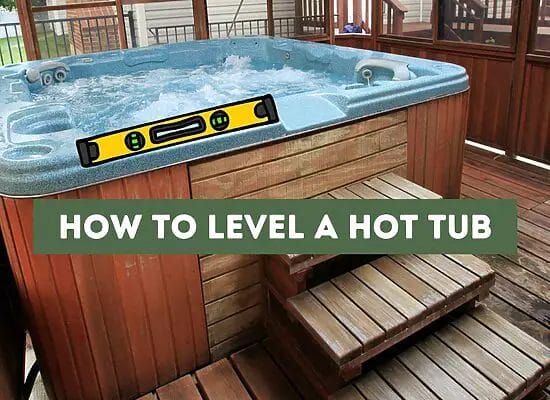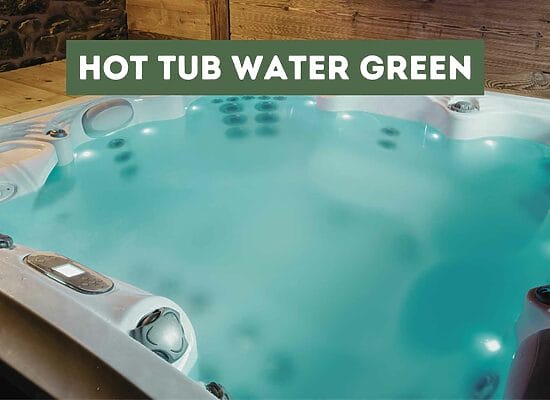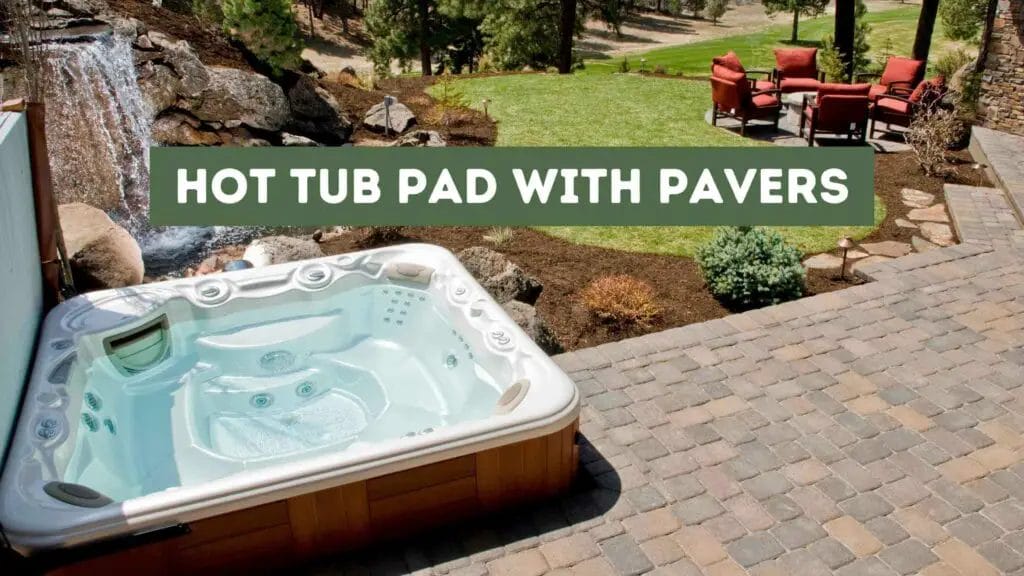
If you’re looking to install a hot tub in your backyard, you may be wondering what surface is suitable for it. One option that comes to mind is pavers. Pavers are a popular choice for outdoor spaces because they are durable, low-maintenance, and come in a variety of colors and shapes. But can a hot tub sit on pavers? The short answer is yes, but there are some important considerations to keep in mind.
Firstly, the pavers must be completely flat and level. Any ridges or bumps could cause the hot tub to shift or become unbalanced, which could be dangerous. Additionally, the pavers should be placed on top of sand or gravel to ensure proper drainage and stability.
When it comes to thickness, the general rule of thumb is that the pavers should be at least 4 inches thick to support the weight of the hot tub and its occupants. However, it’s always best to consult with a professional to determine the exact thickness needed for your specific hot tub.
Key takeaways:
- Suitability of Pavers for Hot Tubs: Pavers are a viable choice for creating a stable and durable base for hot tubs in outdoor spaces due to their durability, low-maintenance, and diverse options in colors and shapes.
- Level and Flat Paver Placement: The pavers must be absolutely level and flat to ensure that the hot tub sits evenly. Any unevenness could lead to instability or unsafe conditions.
- Supporting Weight and Thickness: Pavers used for a hot tub base should be at least 4 inches thick to adequately support the weight of the hot tub and its occupants. Consulting with a professional is recommended to determine the required thickness.
- Hot Tub Weight Distribution: Hot tubs are heavy, with the weight ranging from 500 to 5,000 pounds when filled with water and people. A solid and level base is essential to evenly distribute the weight and prevent damage.
- Preparation and Installation: Proper preparation is crucial for a stable hot tub installation on pavers. Steps include leveling the ground, ensuring proper drainage, using bedding sand, installing the pavers evenly, and potentially adding a layer of sand or gravel for stabilization.
- Types of Pavers: Various paver options are suitable for hot tub bases, including concrete pavers, natural stone pavers, brick pavers, rubber pavers, patio stones, and permeable pavers. Each type offers unique characteristics and benefits.
- Professional Assistance and Building Codes: Seeking professional assistance from contractors or structural engineers is recommended. Additionally, complying with local building codes and regulations is essential to ensure a safe and secure installation.
Understanding Hot Tubs and Pavers
If you are considering installing a hot tub in your backyard, you may be wondering whether it can sit on pavers. Hot tubs are a great way to relax and unwind after a long day, and pavers are a popular choice for creating a stable base for outdoor structures. In this section, we will explore the relationship between hot tubs and pavers to help you make an informed decision.
Hot tubs come in a variety of shapes and sizes, but they all have one thing in common: they are heavy. A typical hot tub can weigh anywhere from 500 to 1,000 pounds (227 to 454 kg) when empty and up to 5,000 pounds (2,268 kg) when filled with water and people. This means that you need a sturdy and level base to support the weight of the hot tub.
Pavers are a great choice for a hot tub base because they are durable and can withstand heavy loads. However, it is important to make sure that the pavers are perfectly flat and level, without any ridges or bumps. This will ensure that the hot tub sits evenly on the pavers and does not wobble or shift.
When choosing pavers for your hot tub base, you should consider the thickness of the pavers. Regular patio pavers are typically four inches (10 cm) thick, but it is recommended to use six-inch (15 cm) thick pavers for driveways and other areas that will be subjected to heavy loads. This will provide additional support and stability for your hot tub.
It is also important to prepare the ground properly before laying the pavers. You should excavate the area to a depth of at least six inches (15 cm) and fill it with a layer of sand or gravel. This will provide a stable base for the pavers and help prevent them from shifting or settling over time.
The Importance of a Solid Base
When it comes to installing a hot tub, having a solid base is crucial. A stable and level base ensures that the hot tub is safe, secure, and operates efficiently. A poorly constructed base can lead to costly damage and even pose a safety risk.
One of the most common types of hot tub bases is a concrete slab. A concrete base provides a stable and durable foundation that can support the weight of a fully loaded hot tub. It is important to ensure that the concrete slab is level and flat to prevent any shifting or movement of the hot tub.
If you are considering using pavers as a hot tub base, it is important to choose pavers that are at least 1.5 to 3 inches thick. Thinner pavers may not provide enough support for the weight of the hot tub. It is also important to ensure that the pavers are laid on a level and stable surface to prevent any shifting or movement.
No matter what type of base you choose, it is important to ensure that the base is solid and stable. This will help prevent any damage to the hot tub and ensure that it operates efficiently. A solid foundation will also provide a more enjoyable hot tub experience, as it will reduce any vibrations or movement.
Preparation and Installation
When installing a hot tub on pavers, proper preparation is crucial to ensure the longevity and stability of your hot tub. Here are some steps to follow:
- Level Ground: The first step is to ensure that the ground where you plan to install your hot tub is level. Use a level tool to check if the ground is even. If it is not, you may need to add or remove soil to level it.
- Drainage: Proper drainage is essential to prevent water from pooling around the hot tub. Consider the slope of the ground and ensure that the hot tub is installed in a location where rainwater will not collect.
- Bedding Sand: Once the ground is level, add a layer of bedding sand. This will provide a level surface for the pavers and help with drainage.
- Pavers: Install the pavers on top of the bedding sand, ensuring that they are flat and level. Use a rubber mallet to tap the pavers into place.
- Sand or Gravel: Once the pavers are in place, add a layer of sand or gravel on top. This will help to stabilize the pavers and prevent them from shifting.
- Concrete Slab: If you prefer, you can also install a concrete slab on top of the pavers. This will provide a more stable base for your hot tub.
- Hot Tub Installation: Finally, it’s time to install your hot tub. Make sure that the hot tub is level and stable on the pavers or concrete slab. Follow the manufacturer’s instructions for filling and draining the hot tub.
Pro Tip: Consider adding a hot tub pad underneath your hot tub for added stability and protection from the elements.
The Role of Weight Distribution
When it comes to placing a hot tub on pavers, one of the most important factors to consider is weight distribution. A filled hot tub can weigh several thousand pounds, and if not distributed properly, this weight can cause damage to not only the pavers but also the surrounding area.
To ensure proper weight distribution, it’s important to consider the capacity of the pavers. Pavers that are too thin or weak may not be able to support the weight of a filled hot tub, leading to cracks or sinking. Ideally, pavers that are at least 1.5 to 3 inches thick should be used for a hot tub base.
In addition to the thickness of the pavers, it’s also important to consider the foundation upon which the pavers are laid. A strong, level foundation will help distribute the weight of the hot tub more evenly, reducing the risk of damage.
Another factor to consider is the number of people who will be using the hot tub. The more people in the hot tub, the more weight it will be carrying. It’s important to ensure that the weight is distributed evenly across the pavers to prevent damage.
One way to ensure proper weight distribution is to use a hot tub pad or base. These products are designed to evenly distribute the weight of the hot tub, reducing the risk of damage to the pavers and surrounding area.
Types of Pavers Suitable for Hot Tubs
When it comes to choosing the right pavers for your hot tub, there are a variety of options available. Here are some of the most popular types of pavers that are suitable for hot tubs:
Concrete Pavers
Concrete pavers are a great option for hot tubs because they are strong, durable, and come in a variety of shapes, sizes, and colors. They are also relatively inexpensive and easy to install. Concrete pavers are available in both smooth and textured finishes, which can help to prevent slips and falls around your hot tub.
Natural Stone
Natural stone pavers, such as flagstone, are a popular choice for hot tubs because of their natural beauty and durability. They come in a variety of colors and textures and can be cut to fit any size or shape of hot tub. Natural stone pavers can be more expensive than other types of pavers, but they are a great investment because they can last for decades with proper maintenance.
Brick Pavers
Brick pavers are a classic choice for hot tubs because of their timeless look and durability. They come in a variety of colors and patterns and can be arranged in a variety of designs to create a unique look for your hot tub area. Brick pavers are also relatively easy to install and maintain.
Rubber Pavers
Rubber pavers are a great option for hot tubs because they are slip-resistant, cushioned, and easy to clean. They come in a variety of colors and patterns and can be cut to fit any size or shape of hot tub. Rubber pavers are also relatively inexpensive, making them a great choice for budget-conscious hot tub owners.
Patio Stones
Patio stones are a versatile option for hot tubs because they come in a variety of shapes, sizes, and colors. They can be arranged in a variety of designs to create a unique look for your hot tub area. Patio stones are also relatively inexpensive and easy to install.
Permeable Pavers
Permeable pavers are a great option for hot tubs because they allow water to drain through them, which can help to prevent slips and falls around your hot tub. They come in a variety of colors and patterns and can be arranged in a variety of designs to create a unique look for your hot tub area. Permeable pavers are also environmentally friendly because they allow rainwater to seep into the ground instead of running off into storm drains.
Pro Tip: When choosing pavers for your hot tub, make sure to choose a type that is strong enough to support the weight of your hot tub when it is filled with water. It is also important to make sure that the pavers are installed on a level surface to prevent any shifting or movement over time.
Cost and Design Considerations
When it comes to installing a hot tub on pavers, there are several cost and design considerations to keep in mind. Pavers are a cost-effective alternative to concrete slabs or decking, but there are still some expenses to consider.
Firstly, you’ll need to ensure that the pavers are thick enough to support the weight of the hot tub. Pavers between 1.5 and 3 inches thick are ideal for a hot tub base and will provide the perfect level of support for the fully loaded weight of the hot tub. However, you can’t just set the pavers on grass or bare ground. You’ll need to prepare the ground properly before laying the pavers.
If you’re planning on doing the installation yourself, you’ll need to factor in the cost of renting or buying any tools you may need, such as a compactor or a saw. You’ll also need to consider the cost of any additional materials, such as sand or gravel, that you may need to prepare the ground properly.
When it comes to design considerations, pavers are a versatile option that can be customized to suit your style and preferences. They come in a variety of colors and patterns, so you can choose the perfect design to complement your patio or landscaping. Interlocking pavers are a popular choice for hot tub bases, as they provide a stable and durable surface that won’t shift or settle over time.
If you’re looking for a more natural look, you can also consider using wood pavers or decking. Wood pavers are made from reclaimed or recycled wood and provide a rustic, eco-friendly option that blends in with your surroundings. However, they may require more maintenance than other types of pavers, such as sealing or staining to prevent rot or decay.
Location and Accessibility
When choosing a location for your hot tub on pavers, it is important to consider accessibility. You want to place your hot tub in a location that is easy to get to and close to your home. This will make it more convenient for you to use your hot tub and will also make it easier to maintain.
When considering the location, think about the plumbing and electrical connections. You will need access to these connections to properly install and maintain your hot tub. Make sure that the location you choose is close to these connections to avoid any issues with installation or maintenance.
You should also consider the walking surface around your hot tub. Pavers are a great option for creating a stable and level surface, but you want to make sure that the area around your hot tub is easy to walk on. Consider using non-slip pavers or adding a non-slip coating to the surface to prevent slips and falls.
To make your hot tub even more accessible, consider adding steps or a ramp. This will make it easier to get in and out of the hot tub, especially for those with mobility issues.
Dealing with Drainage and Weather Conditions
When installing a hot tub on pavers, it is important to consider drainage and weather conditions. Pavers can provide a stable base for your hot tub, but they can also create issues with drainage if not installed properly. Here are some tips to help you deal with drainage and weather conditions when installing a hot tub on pavers.
Drainage
Proper drainage is essential when installing a hot tub on pavers. If water is allowed to accumulate around the base of the hot tub, it can cause damage to the pavers and the hot tub itself. To prevent this from happening, make sure that the pavers are installed on a slope that allows water to drain away from the hot tub. You can also use a drainage system, such as a French drain, to help channel water away from the hot tub.
Rain
Rain can be a problem when installing a hot tub on pavers. If the pavers are not properly sealed, rainwater can seep between the pavers and cause damage to the base of the hot tub. To prevent this from happening, make sure that the pavers are properly sealed before installing the hot tub. You can also use a rain cover to protect the hot tub from rain.
Standing Water
Standing water can be a problem when installing a hot tub on pavers. If water is allowed to accumulate around the base of the hot tub, it can cause damage to the pavers and the hot tub itself. To prevent this from happening, make sure that the pavers are installed on a slope that allows water to drain away from the hot tub. You can also use a drainage system, such as a French drain, to help channel water away from the hot tub.
Professional Assistance and Building Codes
When it comes to installing a hot tub on pavers, it is important to seek professional assistance from a contractor or structural engineer. They can help ensure that the pavers are properly installed and can handle the weight of the hot tub, as well as ensure that the hot tub is level and stable.
It is also important to check local building codes to ensure that the installation is up to code. Some areas may require permits or inspections for hot tub installations. It is better to be safe and comply with regulations rather than face penalties or fines.
A professional contractor can also help with the electrical and plumbing aspects of the installation. They can ensure that the hot tub is properly wired and grounded and that the plumbing connections are secure and leak-free.
It is important to note that hot tubs can be heavy, especially when filled with water and people. Therefore, it is essential to have a solid and level base for the hot tub. Opt for pavers ranging from 1.5 to 3 inches in thickness for an excellent hot tub foundation. These pavers offer optimal support for the hot tub’s full weight when it’s completely loaded.
FAQ: Hot Tub Pad With Pavers
What are the best materials to use for a hot tub base?
When it comes to choosing a base for your hot tub, there are several options available. The most common materials used are concrete, patio pavers, and gravel. Each material has its own advantages and disadvantages. Concrete is durable and long-lasting, but it can be expensive and difficult to install. Patio pavers are a popular choice because they are affordable, easy to install, and come in a variety of colors and styles. Gravel is another option that is inexpensive and easy to install, but it may not provide the same level of stability as concrete or pavers.
How much weight can patio pavers hold?
Patio pavers are strong and durable, but their weight capacity can vary depending on the thickness and quality of the pavers. In general, a 2-inch-thick paver can support up to 4,000 pounds per square foot. However, it’s important to note that the weight of your hot tub will be distributed over several pavers, so it’s unlikely that any single paver will be supporting the full weight of the tub.
Can a hot tub be placed on a paver patio?
Yes, a hot tub can be placed on a paver patio. However, it’s important to ensure that the patio is level and stable before installing the hot tub. The pavers should be perfectly flat and without ridges, and they should be placed on sand or gravel on top of completely level ground. Additionally, it’s recommended to use a hot tub pad underneath the tub to provide additional support and prevent damage to the pavers.
What is the difference between pavers and concrete for a hot tub base?
Both patio pavers and concrete can be used as a base for a hot tub. However, there are some differences between the two materials. Concrete is more durable and long-lasting, but it can be more expensive and difficult to install. Patio pavers are more affordable and easier to install, but they may not be as durable as concrete. Additionally, patio pavers come in a variety of colors and styles, allowing you to customize the look of your hot tub area.
Can an inflatable hot tub be placed on pavers?
Yes, an inflatable hot tub can be placed on pavers. However, it’s important to ensure that the pavers are level and stable before installing the tub. Additionally, it’s recommended to use a hot tub pad underneath the tub to provide additional support and prevent damage to the pavers.
What are the requirements for a hot tub pad on pavers?
A hot tub pad is recommended when placing a hot tub on pavers. The pad should be made of a durable material, such as high-density polyethylene, and should be placed on top of the pavers before the hot tub is installed. The pad should be the same size as the hot tub and should provide a stable and level surface for the tub to rest on. Additionally, the pad should be able to support the weight of the hot tub and its occupants.


